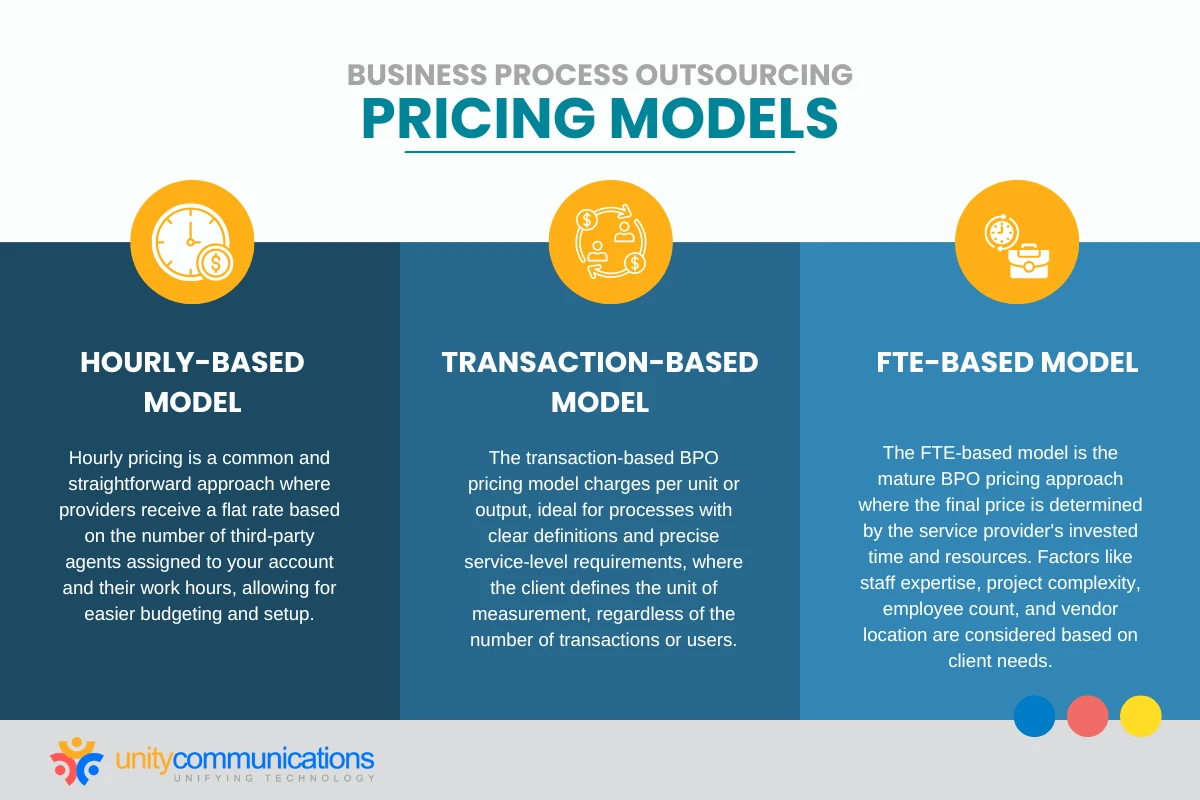Table of Contents
Have you ever received a business process outsourcing (BPO) contract or quote and had no idea what the pricing model would be? BPO pricing models should be clear during the initial process, but that is not always true. Knowing the common pricing structures—hourly, transaction-based, and full-time equivalent (FTE)—helps you understand outsourcing contracts.
Each type of outsourcing pricing scheme provides a different mix of cost-efficiency and service quality, impacting your bottom line and the type of outsourced service you get.
Let us look at the three most common BPO pricing models to determine which is right for you.
Common BPO Pricing Models

Outsourcing is a great option to enhance competitiveness, save on labor costs by 70%, or improve customer service. But you need to use the right pricing structure to maximize its benefits.
BPO models could vary in terms of pricing strategy. This section defines the three most common BPO pricing models: hourly, transaction-based, and FTE-based, and determines where each model most applies. Whether you are nearshoring or offshoring, these are the three models you will choose from.
Hourly-based Model
Hourly pricing is common among call centers, where providers receive a flat rate regardless of how many tickets they handle. This approach is straightforward and similar to many in-house pricing schemes, making it easy to budget for and set up. With this method, you pay according to the total number of third-party agents assigned to your account and their work hours.
Suppose you have 30 agents, each working 40 hours per week to manage your customer service. You pay the service provider a flat fee for the 1,200 hours the agents work per week.
The call center provider is in charge of effectively and accurately deploying agents to manage call volumes. Hence, working with a provider with a reputation for effective scheduling is crucial for this BPO pricing model.
When is hourly pricing best used?
An hourly-based pricing model is ideal for businesses with ticket volumes large enough to justify having a team of full-time agents without much downtime. Clients looking to motivate agents to personalize each customer interaction to enhance the experience and first call resolution (FCR) rate might consider this BPO pricing model.
| Advantages | Disadvantages |
|---|---|
|
|
Transaction-based Model
This BPO pricing model charges per transaction or unit, such as output or data entries by third-party workers. Unlike the FTE-based approach, where effort and input determine the final price, a transaction model uses output as the unit of measurement. In this approach, the client must define what the BPO unit is.
Transaction-based pricing is ideal for business processes with clear definitions, measured in discrete units, and precise service-level requirements. The service-level requirement must remain stable despite the change in the number of transactions or users.
When is transaction-based pricing best used?
This BPO pricing model is best for individual transactions, such as data entry, and other cloud services with specific steps, such as conducting research. Clients prefer this approach when low transaction counts are subject to high fluctuations.
| Advantages | Disadvantage |
|---|---|
|
|
FTE-based Model
Of the three BPO pricing models, the FTE-based model is the most mature. With this approach, the time and resources the service provider has invested in accomplishing the project are the basis of the final price.
Depending on the client’s needs, the service provider considers staff expertise, project complexity, the number of employees, and the vendor’s location.
When is FTE-based pricing best used?
This model applies to a software development project and other complex, contextual processes. Others prefer this approach for cases where tangible output baselines are not relevant or present. This BPO pricing model is useful when transaction levels are high but are not subject to constant fluctuations.
| Advantages | Disadvantage |
|---|---|
|
|
Factors To Consider When Choosing the Right BPO Pricing Model

As per the Deloitte Global Outsourcing Survey 2022 findings, 57% of businesses employ traditional outsourcing strategies primarily to curtail overall expenses. However, choosing the right BPO pricing model plays a pivotal role in determining whether companies can fully capitalize on the benefits of outsourcing. Engaging the assistance of a business solution consultant is a prudent step to ascertain the most suitable approach.
So, which of the three most prevalent models aligns with your specific requirements? Consider the following factors to gauge how closely they align with your existing objectives and needs:
- High call volumes with emphasis on customer experience. Opt for the hourly approach, as it offers heightened flexibility and assurance in delivering an exceptional customer experience, regardless of the time required to resolve each case.
- Prioritized efficiency and speed. Select the per-transaction option, which enables you to pay solely for the services you require, thereby incentivizing agents to prioritize efficiency and speed.
- One-off projects and low call volumes. The transaction-based model proves most advantageous for scenarios characterized by low or erratic call volumes and brief-term projects. It allows you to outsource and remunerate only for the necessary work volume.
- More focus on service over speed. Opt for the FTE-based approach when a greater emphasis is placed on service quality over speed, in contrast to the transaction-based model. This model serves as motivation for agents to prioritize the delivery of exceptional service.
Importance of Choosing the Right BPO Pricing Model
The ramifications of selecting an ill-fitting BPO pricing model are readily discernible through various scenarios:
Agents may create accounts for additional services in pursuit of financial incentives without obtaining the client’s consent or knowledge.
Overemphasizing a single metric can lead to similar undesirable outcomes.
Without effective checks and balances, incentive programs might be susceptible to abuse.
While choosing the right pricing structure may not be a panacea, it plays a pivotal role in aligning your objectives with the BPO services provided. The absence of such alignment can result in detrimental consequences, including:
- Diminished service quality
- Counterproductive behaviors and processes
- Adverse impacts on customers
- Long-term efficiency compromises
More significantly, businesses may struggle to uphold their brand promise, resulting in a substantial erosion of integrity, diminished customer loyalty, and reduced revenue. Ensuring the appropriateness of the BPO pricing model extends beyond benefiting the client alone; it revolves around establishing a framework that not only fulfills customer expectations efficiently but also minimizes wastage.
The Bottom Line
Choosing the right pricing approach for your outsourced service is no easy feat. You risk choosing the wrong model if you are unclear about your project’s needs. The wrong approach often leads to delays and unexplained expenses.
Make strategically considered and well-thought-out decisions to maximize the benefits of outsourcing. When choosing the right BPO pricing model, take your time to assess the different options.
Looking for a reliable outsourcing solution with a pricing scheme that works for you? Drop us a line, and let’s connect!



